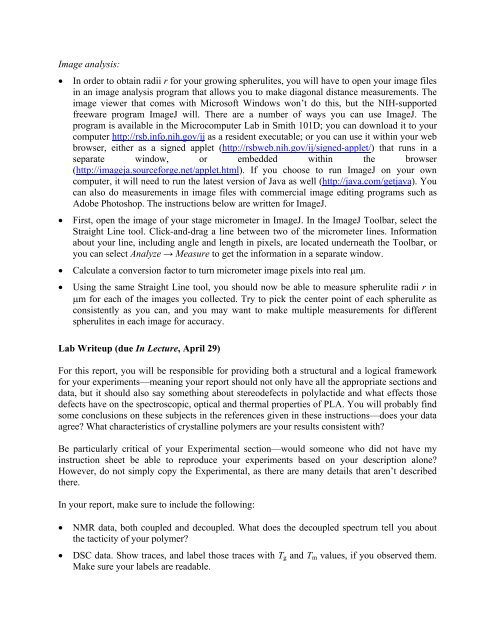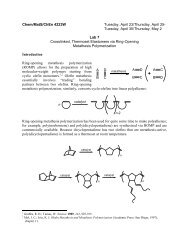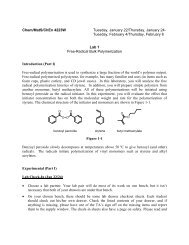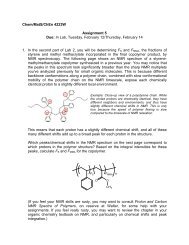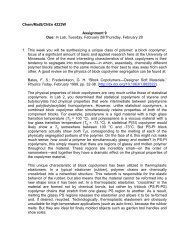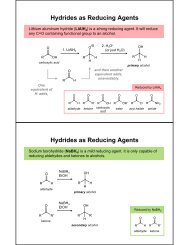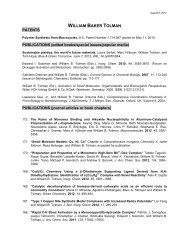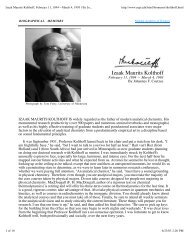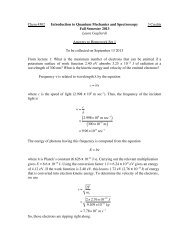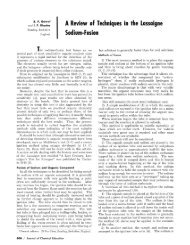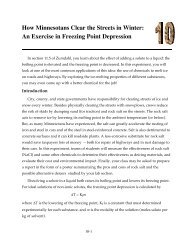Chem/MatS/ChEn 4223W Tuesday, April 2/Thursday, April 4 ...
Chem/MatS/ChEn 4223W Tuesday, April 2/Thursday, April 4 ...
Chem/MatS/ChEn 4223W Tuesday, April 2/Thursday, April 4 ...
You also want an ePaper? Increase the reach of your titles
YUMPU automatically turns print PDFs into web optimized ePapers that Google loves.
Image analysis: In order to obtain radii r for your growing spherulites, you will have to open your image filesin an image analysis program that allows you to make diagonal distance measurements. Theimage viewer that comes with Microsoft Windows won’t do this, but the NIH-supportedfreeware program ImageJ will. There are a number of ways you can use ImageJ. Theprogram is available in the Microcomputer Lab in Smith 101D; you can download it to yourcomputer http://rsb.info.nih.gov/ij as a resident executable; or you can use it within your webbrowser, either as a signed applet (http://rsbweb.nih.gov/ij/signed-applet/) that runs in aseparate window, or embedded within the browser(http://imageja.sourceforge.net/applet.html). If you choose to run ImageJ on your owncomputer, it will need to run the latest version of Java as well (http://java.com/getjava). Youcan also do measurements in image files with commercial image editing programs such asAdobe Photoshop. The instructions below are written for ImageJ. First, open the image of your stage micrometer in ImageJ. In the ImageJ Toolbar, select theStraight Line tool. Click-and-drag a line between two of the micrometer lines. Informationabout your line, including angle and length in pixels, are located underneath the Toolbar, oryou can select Analyze → Measure to get the information in a separate window. Calculate a conversion factor to turn micrometer image pixels into real m. Using the same Straight Line tool, you should now be able to measure spherulite radii r inm for each of the images you collected. Try to pick the center point of each spherulite asconsistently as you can, and you may want to make multiple measurements for differentspherulites in each image for accuracy.Lab Writeup (due In Lecture, <strong>April</strong> 29)For this report, you will be responsible for providing both a structural and a logical frameworkfor your experiments—meaning your report should not only have all the appropriate sections anddata, but it should also say something about stereodefects in polylactide and what effects thosedefects have on the spectroscopic, optical and thermal properties of PLA. You will probably findsome conclusions on these subjects in the references given in these instructions—does your dataagree? What characteristics of crystalline polymers are your results consistent with?Be particularly critical of your Experimental section—would someone who did not have myinstruction sheet be able to reproduce your experiments based on your description alone?However, do not simply copy the Experimental, as there are many details that aren’t describedthere.In your report, make sure to include the following:NMR data, both coupled and decoupled. What does the decoupled spectrum tell you aboutthe tacticity of your polymer?DSC data. Show traces, and label those traces with T g and T m values, if you observed them.Make sure your labels are readable.


